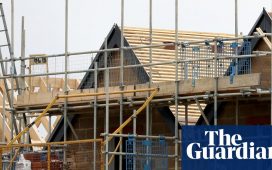The decision by the Royal Borough of Greenwich to say enough is enough and order the demolition of 204 homes at the Mast Quay development in south-east London casts a spotlight on one of the most unequal battles in the public realm – between major developers and town hall planners.
And it is one that often enrages the public. Greenwich’s gambit has cheered community groups who say they are feeling increasingly powerless to challenge, even with the help of the planning system, the might of developers.
And it comes after the unauthorised demolition of the Crooked House pub in Staffordshire – another dramatic example of a property owner allegedly ignoring planning officers’ wishes.
Pulling down the Mast Quay buildings in Woolwich would be “pretty extreme”, said Sebastian Charles, the chair of the Law Society’s planning and environmental law committee. The government’s planning inspectorate now appears likely to be asked to consider whether the apartments, as built, warrant planning permission. It could be a high-stakes ruling.
For more than 75 years, since the Town and Country Planning Act of 1947 came into effect, development in this country has relied on both sides playing by the rules. After permission for a building is granted, most significant design changes must be checked with the planners. It is a negotiation and it relies not only on trust, but on there being enough planners to respond.
And if developers err from the plans, there are currently very few officials to stop them – which partially explains why Greenwich only very belatedly appears to have spotted the problems at Mast Quay II.

To a large degree, developers are self-policing. Often they borrow large sums of money to build. Lenders need to know they are not throwing money into investments that risk being pulverised over a planning row. So checks are normally made within a project team.
But even large councils only have a handful of planning enforcement officers – six would be a large number, according to the Royal Town Planning Institute. Most of their work is reacting to complaints about a neighbour’s domestic extension breaching planning consent, or a hedge or a tree being pulled down, said Richard Blyth, the head of policy practice and research at RTPI.
That leaves little time for “proactive enforcement” – like checking if the 23-storey building going up by the Thames looks like the visualisations. Last year, an RTPI survey of 103 councils found that 90% had an enforcement backlog and 80% said they didn’t have enough enforcement officers for the workload.
And in an era when major councils like Birmingham are going bust, planning enforcement is a low priority. Unlike granting permissions, there are no fees attached. Every pound spent policing the developers has to come from central council funding, Blyth said.
Official figures on enforcement suggest either developers are increasingly conforming to planning law or the reach of planners is declining. In 2015-16 more than 5,000 enforcement notices were issued, but by 2022-23 that had fallen to less than 3,600, according to the Department for Levelling Up, Housing and Communities.
The battle at Mast Quay II now has months to run. In the meantime, the renters who live there face unwelcome uncertainty.










